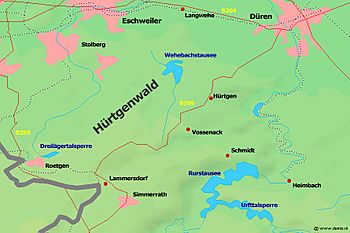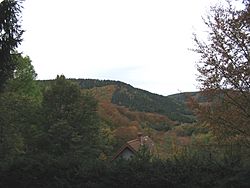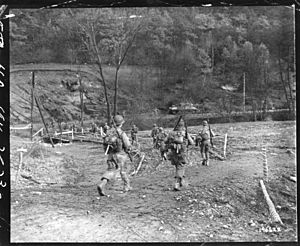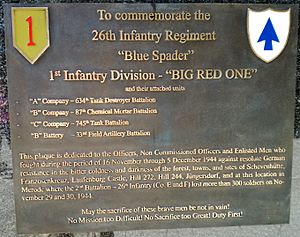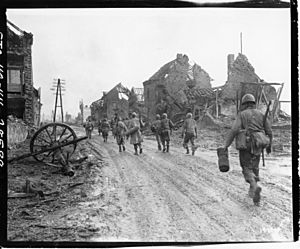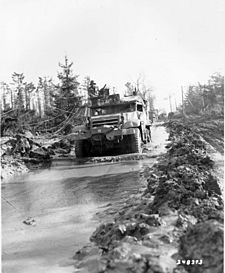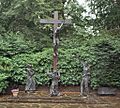Battle of Hürtgen Forest facts for kids
Quick facts for kids Battle of Hürtgen Forest |
|||||||
|---|---|---|---|---|---|---|---|
| Part of the Western Front of World War II | |||||||
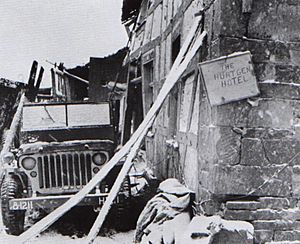 A farmhouse in Hürtgen served as shelter for HQ Company, 121st Infantry Regiment, 8th Infantry Division, XIX Corps, 9th US Army. They nicknamed it the "Hürtgen Hotel". |
|||||||
|
|||||||
| Belligerents | |||||||
| Commanders and leaders | |||||||
| Strength | |||||||
| 120,000 | 80,000 | ||||||
| Casualties and losses | |||||||
| 33,000 to 55,000 | 28,000 | ||||||
The Battle of Hürtgen Forest (German: Schlacht im Hürtgenwald) was a series of intense battles during World War II. It took place from September 19 to December 16, 1944. American and German forces fought in the Hürtgen Forest, a large wooded area in Germany. This battle was the longest single battle the U.S. Army has ever fought. It was also the longest battle on German soil during World War II.
American commanders first wanted to keep German forces busy in the forest. This would stop them from sending help to other battle areas further north. The U.S. forces were fighting near Aachen against the strong German defenses called the Siegfried Line. The Americans also aimed to capture the village of Schmidt and clear the town of Monschau. Later, they planned to move towards the Rur River.
The German commander, Walter Model, wanted to stop the Allied advance completely. He used the strong defenses of the Westwall, also known as the Siegfried Line. The battle was very costly for the U.S. First Army. They suffered at least 33,000 soldiers killed or wounded. Some estimates go as high as 55,000 casualties. German forces had about 28,000 casualties.
The Germans fought hard because the forest was a key area for their winter attack. This attack was called Wacht am Rhein, or the Battle of the Bulge. The mountains in the forest also controlled access to the Rur Dam. If the Germans released the water from the dam, it could flood Allied troops. The Allies failed to capture the area after many setbacks. The Germans held the region until they launched their last major attack in the Ardennes. This attack began on December 16, ending the Hürtgen offensive. The Battle of the Bulge became very famous, so the Battle of Hürtgen Forest is less remembered.
Contents
Why Did the Battle Happen?
By mid-September 1944, the Allied armies were slowing down. They had advanced quickly after the Normandy landings, but their supply lines were stretched. German resistance was also growing stronger. The next big goal was to reach the Rhine River and prepare to cross it.
The U.S. First Army, led by Courtney Hodges, faced tough resistance near Aachen. They worried that German forces in the Hürtgen Forest could attack them from the side. The U.S. 1st Infantry Division arrived in early October. They joined other U.S. units that had surrounded Aachen. The Germans in Aachen refused to surrender until October 21.
American commanders also felt they needed to control the Rur Dam. If the Germans blew up the dam, the water could flood any Allied forces downstream. Commanders like Omar Bradley and Courtney Hodges believed the direct way to the dam was through the forest. However, some historians now question if fighting in the forest was truly necessary.
What Was the Hürtgen Forest Like?
The Hürtgen Forest is a rough area between the Rur River and Aachen. In late 1944, the weather was cold, wet, and cloudy. This often stopped air support from helping the Allied troops. The thick forest and difficult land also made it hard for Allied planes to spot targets.
The forest had few roads, paths, or clearings. This made it hard for vehicles, especially tanks, to move. The ground became very muddy, making travel even tougher. German defenders had set up hidden blockhouses, minefields, barbed wire, and booby-traps. Many concrete bunkers from the Siegfried Line were also in the area.
The dense forest allowed soldiers to sneak around and attack from the sides. It was hard to know where the front line was or if an area was truly clear of enemies. The few clearings allowed German machine guns and artillery to fire very accurately. The American advantages in numbers, tanks, and air support were greatly reduced by the weather and terrain. Small numbers of determined German defenders could be very effective. As American divisions lost soldiers, new, inexperienced replacements had to join the fighting right away.
Who Fought in the Battle?
The Hürtgen Forest was part of the area controlled by the U.S. First Army. This army was led by Courtney Hodges. Different U.S. Army Corps, like the V Corps and VII Corps, took turns leading the fight.
At first, the forest was defended by two German infantry divisions. These divisions were not at full strength but were well prepared. They had about 5,000 men and 150 artillery pieces. As the battle went on, more German soldiers arrived. The Americans had hoped these German troops were weak, but they were wrong.
American Divisions
- 1st Infantry Division
- 4th Infantry Division
- 8th Infantry Division
- 9th Infantry Division
- 28th Infantry Division
- 78th Infantry Division
- 82nd Airborne Division
- 3rd Armored Division
- 2nd Ranger Battalion
German Divisions
- 85th Infantry Division
- 275th Infantry Division
- 353rd Infantry Division
- 3rd Parachute Division
- 116th Panzer Division
- 12th Volksgrenadier Division
- 272nd Volksgrenadier Division
Key Moments of the Battle
Early Attacks in September
The battle began on September 19, 1944. The U.S. 9th Infantry Division aimed to reach the Rur River crossings at Düren. An early attack captured Schevenhütte with few losses. However, other attacks faced strong German resistance and were pushed back. The 9th Division tried to push through the forest to capture Hürtgen and Kleinhau. But the difficult land and prepared German positions stopped them.
By October 16, the Americans had gained only about 3,000 yards (2,700 meters). This came at a high cost of 4,500 casualties. The U.S. 28th Infantry Division then arrived to replace the exhausted 9th Division.
The 28th Division's Struggle
The 28th Division's attack started on November 2. The Germans were ready for them. The U.S. 109th Infantry Regiment was stopped by an unexpected minefield and heavy fire. They gained only about 300 yards (270 meters) in two days. The U.S. 110th Infantry Regiment faced similar problems trying to clear woods and keep supply routes open.
The U.S. 112th Infantry Regiment captured Vossenack and a nearby ridge. Two of its battalions then crossed the Kall Valley and captured Kommerscheidt and Schmidt on November 3. However, American supplies and help were very limited. The Kall Trail, their main supply route, was difficult and infiltrated by Germans.
On November 4, a strong German counter-attack with tanks pushed the Americans out of Schmidt. The U.S. 112th's 3rd Battalion was overwhelmed and retreated. Only three American tanks managed to cross the Kall Valley to help. The Germans attacked Kommerscheidt several times. The Americans held on until November 8, when they were ordered to pull back. The positions at Schmidt and the Kall Trail were abandoned. The U.S. Army did not fully capture the Kall Trail and Schmidt until February 1945.
During this time, a German doctor, Günter Stüttgen, arranged a ceasefire at the Kall Bridge. From November 7 to 12, both sides helped their wounded soldiers. Many American lives were saved by German medics.
The Push to the Rur River
The second phase of the battle was part of Operation Queen. This was an Allied effort to reach the Rur River. The U.S. 4th Infantry Division was tasked with clearing the northern part of the forest. They were to capture Hürtgen and advance to the Rur south of Düren. This attack began on November 16.
The American regiments faced heavy resistance and suffered many losses. After three days, there were 300 casualties, including many officers. By November 18, tanks were needed, so engineers blasted paths through the forest. German reinforcements arrived, making resistance even stronger.
The U.S. 8th Infantry Division attacked on November 21. They moved towards Hürtgen. Despite tank support, they advanced less than 600 yards (550 meters) each day. Hürtgen was finally captured on November 29. The fighting continued to Kleinhau, about 1 mile (1.6 km) north.
The last major action in the Hürtgen Forest was near Langerwehe-Merode. American companies took the village, but a German counter-attack destroyed them. Over 300 soldiers from the 1st Infantry Division died on November 29 and 30.
On December 6, U.S. Rangers captured the important Hill 400 from German defenders. However, the Germans later retook the hill. The U.S. Army did not seize Hill 400 again until February 1945.
By December 15, the fighting along the Siegfried Line had caused huge losses. More than 250,000 soldiers from both sides were killed, wounded, or captured. The U.S. First and Ninth Armies had over 57,000 battle casualties. They also had over 71,000 non-battle casualties from things like accidents, diseases, and stress. German forces had about 12,000 dead and 95,000 captured.
On December 16, 1944, German forces launched the Battle of the Bulge. This major offensive ended the fighting in the Hürtgen Forest.
What Happened After the Battle?
The Battle of Hürtgen Forest ended as a German defensive victory. It was a very difficult and costly battle for the Allies. The Americans suffered between 33,000 and 55,000 casualties. This included about 9,000 non-combat losses, like from illness. The Germans also had heavy losses, with 28,000 casualties.
The surprise German attack in the Battle of the Bulge caught the Allies off guard. The Germans attacked with nearly 30 divisions, including elite Panzer divisions. They pushed a large bulge into the American lines, almost 60 miles (97 km) deep. However, the Germans never reached their main goal, which was to capture Antwerp. The Ardennes Offensive stopped in early January. This was because of strong American defense, destroyed bridges, and a lack of fuel for the Germans.
In early February 1945, American forces attacked through the Hürtgen Forest one last time. On February 10, the Rur Dam was captured. The forest itself was not fully cleared until February 17, when the 82nd Airborne Division reached the Roer River.
Remembering the Battle
There is a stone monument at the Hürtgen Military Cemetery. It has a bronze plaque dedicated by U.S. 4th Infantry Division veterans. It honors Friedrich Lengfeld, a German lieutenant. Lengfeld died on November 12, 1944, from severe wounds. He was helping a wounded American soldier out of a minefield. This is the only memorial for a German soldier placed by his former enemies in a German military cemetery.
A sculpture on the Kall Bridge also remembers this moment of humanity during the war. It was dedicated on November 7, 2004, the 60th anniversary of the ceasefire at the bridge. The sculptor, Michael Pohlmann, wanted to create a simple shape that honored the place where sanity returned amidst the horrors of war.
The 1944 Hürtgen Forest Museum opened on March 29, 1983, in Kleinhau. It is in a stone barn and helps people remember the battle.
Images for kids
See Also
- Battle of Crucifix Hill
- When Trumpets Fade, a 1998 HBO film about the battle
- Assault on Hill 400, a 2023 film


